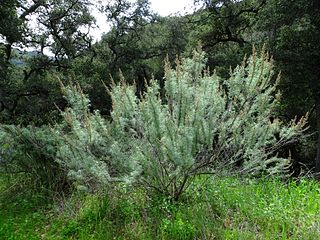
Ragweeds are flowering plants in the genus Ambrosia in the aster family, Asteraceae. They are distributed in the tropical and subtropical regions of the Americas, especially North America, where the origin and center of diversity of the genus are in the southwestern United States and northwestern Mexico. Several species have been introduced to the Old World and some have naturalized and have become invasive species. In Europe, this spread is expected to continue, due to ongoing climate change.

Ambrosia artemisiifolia, with the common names common ragweed, annual ragweed, and low ragweed, is a species of the genus Ambrosia native to regions of the Americas.

Ambrosia dumosa, the burro-weed or white bursage, a North American species of plants in the family Asteraceae. It is a common constituent of the creosote-bush scrub community throughout the Mojave Desert of California, Nevada, and Utah and the Sonoran Desert of Arizona and northwestern Mexico.

Artemisia californica, also known as California sagebrush, is a species of western North American shrub in the sunflower family.

Ambrosia trifida, the giant ragweed, is a species of flowering plant in the family Asteraceae. It is native to North America, where it is widespread in Canada, the United States, and northern Mexico.

Ambrosia ambrosioides, also known as canyon ragweed or chicura, is a ragweed found in the deserts of northern Mexico, Arizona, and California.

Ribes viburnifolium, is an uncommon North American species in the gooseberry family. It is known by the common names Catalina currant, Santa Catalina Island currant, island gooseberry and evergreen currant.

Ambrosia chamissonis is a species of ragweed known by the common names silver burr ragweed, silver beachweed and (silver) beach bur(r).

Ambrosia psilostachya is a species of ragweed known by the common names Cuman ragweed and perennial ragweed, and western ragweed.

Ambrosia chenopodiifolia is a species of ragweed known by the common names San Diego bursage and San Diego bur ragweed. It is native to the Mexican states of Baja California and Baja California Sur, as well as to Orange and San Diego Counties it int US State of California. It is a member of the coastal sage scrub plant community.

Ambrosia confertiflora is a North American species of ragweed known by the common name weakleaf bur ragweed.

Ambrosia eriocentra is a North American species of ragweed known by the common names woolly bursage and woollyfruit burr ragweed.

Ambrosia ilicifolia is a species of ragweed known by the common names hollyleaf burr ragweed and hollyleaf bursage.

Artemisia palmeri is a rare species of sagebrush known by the common names San Diego sagewort and Palmer sagewort.

Antigonon leptopus is a species of perennial vine in the buckwheat family commonly known as coral vine or queen's wreath. This clambering vine is characterized by showy, usually pink flowers that can bloom throughout the year and large, heart-shaped leaves. A. leptopus is native to the Pacific and Atlantic coastal plains of Mexico, but also occurs as a roadside weed from Mexico south to Central America. It is widely introduced and invasive throughout tropical regions of the world, including in the south and eastern United States, the West Indies, South America, and the Old World tropics of Asia and Africa. This species is utilized for its edible tubers and seeds, but also for its horticultural properties as an ornamental vine in warmer parts of the world.
Ambrosia cheiranthifolia is a rare species of flowering plant known by the common names South Texas ambrosia and Rio Grande ragweed. It is native to the coast of South Texas and the Mexican states of Tamaulipas and Coahuila. It occurs in coastal prairie, grassland, and mesquite shrubland habitat. It has declined because its native habitat has been cleared for development, with remaining open savanna invaded by non-native grasses such as buffelgrass. Today there are perhaps 20 populations remaining, but some of these may have very few genetic individuals because the species is clonal, with many cloned plants attached by one rhizome. It is not certain that the plant still exists in Mexico. This is a federally listed endangered species of the United States.

Ambrosia deltoidea is a North American species of flowering plant in the family Asteraceae known by the common names triangle bur ragweed, triangle bursage, and triangleleaf bursage.

Ambrosia salsola, commonly called cheesebush, winged ragweed, burrobush, white burrobrush, and desert pearl, is a species of perennial shrub in the family Asteraceae native to deserts of the southwestern United States and northwestern Mexico.

Ambrosia cordifolia, called the Tucson bur ragweed, is a North American species of plant in the family Asteraceae. It is native to northern Mexico and the State of Arizona in the United States.

Ambrosia monogyra is a species of flowering plant in the sunflower family commonly known as the singlewhorl burrobrush, leafy burrobush, slender burrobush, and desert fragrance. Ambrosia monogyra is native to North America and is typically found in canyons, desert washes, and ravines throughout arid parts of the southwestern United States and northern Mexico. This species has green, threadlike leaves that emit a distinctive odor when crushed, and flowers from August to November. The fruits have distinctive wings in their middle that aid in dispersion through wind and water.




















